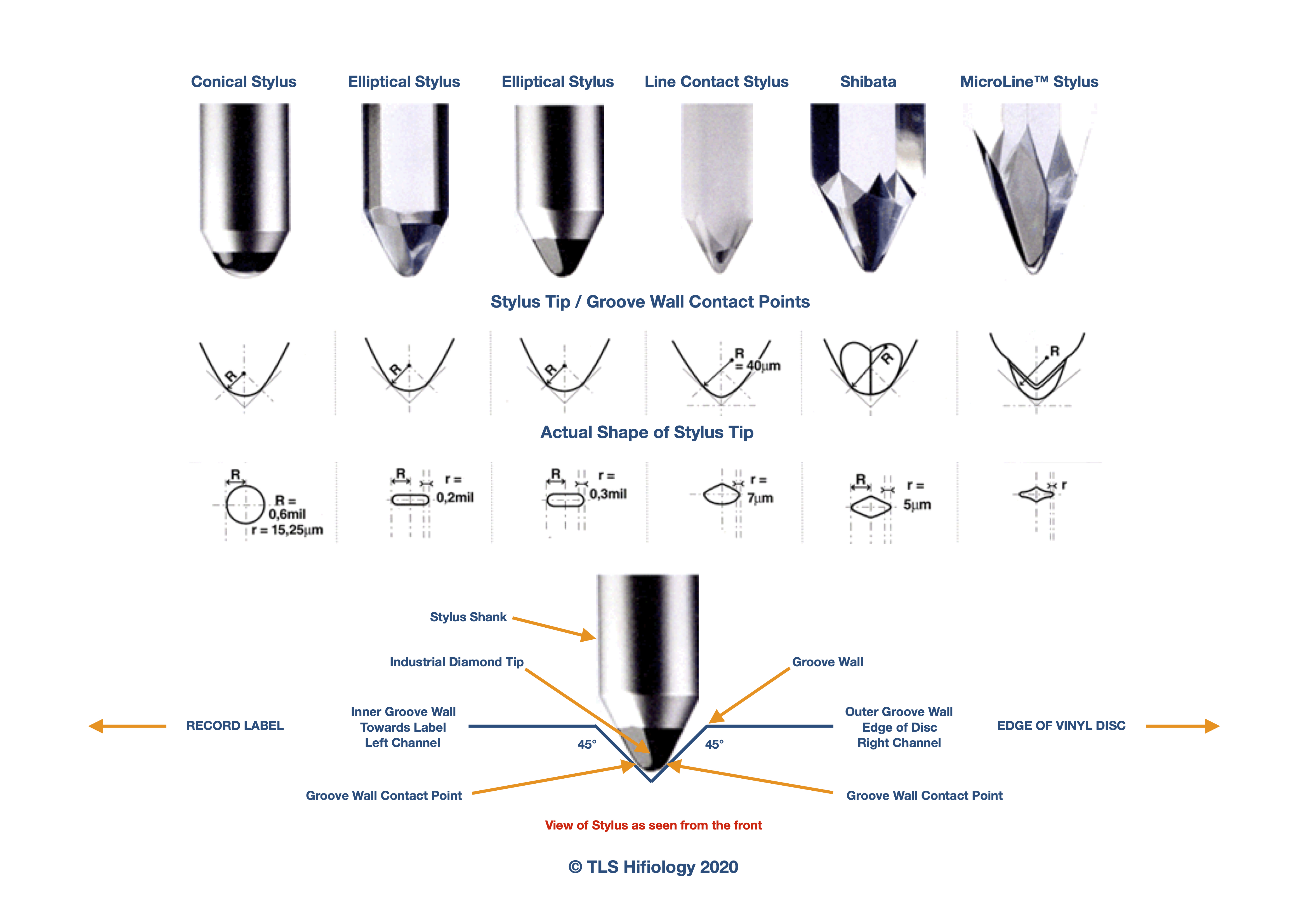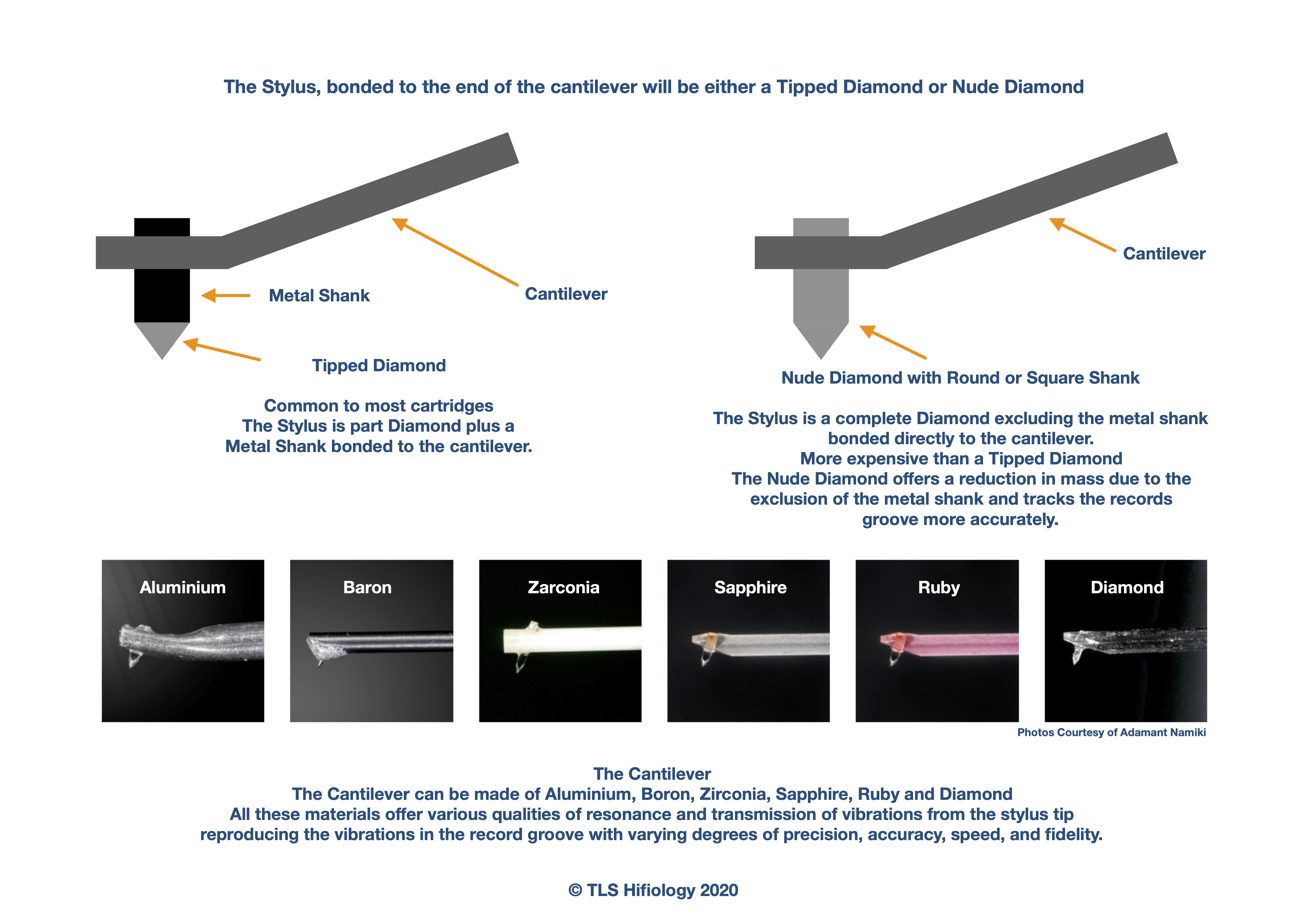Why are some Styli & Cartridges more expensive than others ?
Both the shape of the stylus and the materials used to construct the stylus, cantilever, magnets and coils all contribute to the overall cost of the cartridge, and to how well they replicate the vibrations within the groove of the record, plus the wear and tear over time of your record collection.
Precise alignment of the stylus and cartridge is extremely important and required to obtain the best possible performance. There are various stylus and cartridge types available to choose from, all offering different levels of performance which is reflected in their cost.
Note: A very expensive stylus / cartridge will only perform at its best when combined with a tone arm and turntable of the same caliber. It is absolutely pointless mounting an expensive cartridge onto a tonearm which does not allow precise stylus, cartridge and tonearm alignment.
Shapes & Types


Conical / Spherical
They are the most common, least expensive and easiest to align. When magnified the tip of the stylus looks like a ballpoint pen. They have a short life span and produce the most wear and tear inside the records groove walls.
Elliptical / Hyperelliptical Bi or Dual Radial
Elliptical styli offer more precise tracking and groove wall contact and do require far more precise stylus, cartridge and tonearm alignment. They have a longer vertical contact area and a narrower front to back contact area within the record groove. The payback is reduced wear and tear, improved high frequency and phase response, plus lower distortion particularly nearing the end of the record disc in the hard-to-track inner grooves.
Advanced Stylus Shapes
Line Contact
Fine Line
Micro-Line
Micro-Ridge
Shibata invented by Norio Shibata of JVC
Stereohedron
S.A.S
Parabolic
Paratrace
Vital
Microscanner
Fritz Geiger
Due to their advanced shape and design they are far more expensive than an elliptical stylus and definitely require far more precise stylus, cartridge and tonearm alignment. These styli are the most advanced of all the styli types, they are difficult to manufacture and expensive.
The computer designed tips are similar to the shape of a cutting stylus used to cut master lacquer discs. They are far lighter in weight offering the best tracking and high-frequency performance, with less distortion, particularly nearing the end of the record in the hard-to-track inner grooves. Their multilevel “ridge” shapes allow these styli to offer superior imaging and depth, with greatly reduced groove and stylus wear and tear.
Reasons for Investing and Upgrading your Cartridge and Stylus
The Vinyl Groove
A 12'' vinyl record spins at 33 1/3 RPM, at this speed it takes two seconds of music to travel approximately 36 inches around the outside of the record and 14.9 inches around the inside. As the groove of a vinyl record spirals inward from the outside of the disc towards the label, the length of the groove per revolution on the inside of the disc is shorter than on the outside of the disc. Because of this, the reduced space on the disc near to the label restricts the spacing between the groove walls, the depth of the groove and subsequently affects the stylus ability to track the groove, consequently, the record suffers some hi frequency loss plus distortion halfway through the LP. So the more refined the stylus, cantilever and cartridge the better the reproduction.
The Cutting Engineer
The cutting engineer compensates for this hi frequency loss plus distortion by cutting louder tracks on the outside of the disc and quieter tracks on the inside of the disc. Louder tracks require more space for a deeper, wider groove depth and cut for volume and clarity. The shorter in time the tracks are on an LP, the better, resulting in improved dynamics and volume. The longer or more tracks that are cut, the quieter and less dynamic the record will be, plus there will be increased surface noise.
Study the grooves on a 12’’ remix record running at 45rpm and you will see that the groove is cut deeper and wider this is because there is only one track per side and the cutting engineer can use all the space available to cut a deeper and wider groove resulting in a louder and clearer vinyl cut.
This is why 12’’ 45rpm discs with one or two tracks always sound better than 12’’ 33 1/3 rpm with multiple tracks.
Lacquer cutting discs used for the production 12’’ Vinyl Records running at 33 1/3 rpm offer an optimum of 12 to 14 mins and maximum of 22 to 24 mins cutting time. Lacquer cutting discs used for the production of 12’’ Vinyl Records running at 45rpm offer an optimum of 9 mins and maximum of 12 to 15 minutes cutting time.
RIAA Equalisation Curve
(Recording Industry Association of America)
The cutting engineer also uses what’s called an RIAA pre-emphasis equalization curve during the process of cutting the record, this equalisation reduces low frequencies by 20dB and boosts the high frequencies by 20dB.
Frequencies below 1Khz are rolled off by 6 dB per octave reaching -20dB at 20Hz
Frequencies above 1Khz are boosted by 6 dB per octave reaching +20dB at 20Khz
The reason for using this curve is to create more space on the disc by reducing the groove width, permitting longer track times. Boosting the high frequencies greatly reduces high-frequency surface noise during the cutting process. During playback of the record on a turntable, the Phono Stage reverses the RIAA equalization curve as used by the cutting engineer by boosting the low frequencies and reducing the hi frequencies canceling the effect of the preemphasis curve applied during the cutting process.
Hifiology - Quicklinks
Record Player, Record Deck, Turntable
https://www.thelisteningsuite.ie/record-player-record-deck-turntable/
The Stylus - Shapes, Types
https://www.thelisteningsuite.ie/the-stylus-shapes-types/
The Stylus - Needle in the Groove
https://www.thelisteningsuite.ie/the-stylus-needle-in-the-groove/
The Cartridge - Moving Magnet or Coil
https://www.thelisteningsuite.ie/the-cartridge-moving-magnet-or-coil/
The Cartridge - The Assembly
https://www.thelisteningsuite.ie/the-cartridge-the-assembly/
The Tonearm - Shapes & Sizes
https://www.thelisteningsuite.ie/the-tonearm-shapes-sizes/
The Tonearm - Geometry & terms
https://www.thelisteningsuite.ie/the-tonearm-geometry-terms/
The Phonostage
https://www.thelisteningsuite.ie/the-phono-stage/